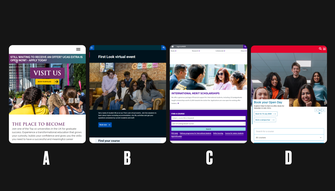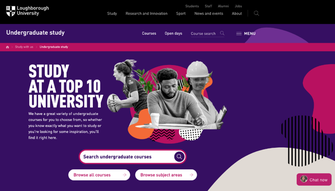How to make your university website stand out
Most university websites fail to stand out. But those that dare to be different see excellent results. In this article we lay out why university websites look the same, and how you can avoid this for your university.
A university’s website is its most effective marketing tool, and yet those websites often fail to capture what makes the institution unique. We frequently see websites that are so generic, it would be impossible to determine which university they are intended to represent if the logo was removed. This is a significant problem for prospective students who care deeply about the spirit and character of the place they will study, and the people they will meet.
The most successful university websites have a strong sense of their unique identity and use impactful design to embody and communicate that identity online.
To share our thinking on this issue, we recently ran a webinar: ‘Who’s website is this anyway? How to make your university stand outline’. In this session our Creative Strategy Lead, Dr. Tom Jackson, set out our case for rethinking how universities present themselves online. He was joined by our Senior Designer Craig Laing and our client Luke Berry, Senior Website and Performance Manager at the University of Hull.
In this article, we’ve summarised our key arguments and takeaways from that session. You can also watch the recording to see it for yourself.
Why do university websites tend to look the same?
If you’ve spent any time looking at university websites, you probably won’t need much convincing that they all tend to look very similar.
To prove our point that most university websites don’t stand out, we chose four at random and removed their logos.
The websites shown below are the homepages of Sheffield, Leicester, Winchester and Southampton universities.

During the webinar, only 48% of participants were able to correctly identify A as Winchester, and that was the strongest result. 35% correctly identified B as Southampton, 25% correctly identified C as Sheffield, and 40% correctly identified D as Leicester. So there is clearly an issue here… We’re not trying to say these websites are bad, they are just too similar to stand out to prospective students in a competitive marketplace. Like most university websites, they lack differentiation.
Take the example of Edinburgh and York universities. These are both prestigious institutions, and yet their websites are strikingly similar and suffer from many of the same UX problems.

Both of these homepages are overcrowded, bombarding the user with far too many calls to action. They do not convey a coherent, unique vision of what the institution is about, and other than minor layout differences, they look and sound strikingly similar. That’s not to say Edinburgh or York universities have particularly bad websites. Our intention is not to pick on any one institution, but simply to point out that this lack of differentiation is a sector-wide issue.
Why is this a problem?
We’ve established that university websites tend to look very similar. But why is this such a significant problem? Recent research shows that prospective students are using university websites extensively when assessing which universities to apply to, and the lack of a distinctive identity makes it hard for students to ‘get’ what each university is about or picture themselves there. According to Study International, 50% of home students decide where to study based on the website alone, and 91% of international students are ‘stealth applicants’, making no direct contact with the university (such as attending an open day) before applying, and therefore also rely heavily on the website to make their decision.
We often interview prospective students during our discovery research for university clients, and we find time and again that they want the website to convey a sense of what life is like at the university and what makes that university different from all of the rest. It’s clear that they are often not getting this.
This quote from a student we recently interviewed perfectly captures the prevailing mood: “I wanted to know about life at the university … not like ‘Here we are on the league table.’ ‘This is how much money we've spent on this building”.
How to make your university stand out?
Realising your university website needs to differentiate itself is just the first step. Next, you need to work on how to truly stand out in a crowded and competitive space. This is a challenge we’ve grappled with over many years for our higher education clients. We’ve concluded that you have to be ambitious, creative and willing to embrace what you’re known for.
The most common pitfall we see is universities claiming distinctiveness based upon a standard set of qualities, and therefore not standing out at all. Qualities such as a ‘warm and welcoming environment’, ‘excellent teaching’, ‘a vast range of student societies’ are, of course, incredibly important, but they are also claimed by almost every university in the country, so they don’t present a distinctive offering.
Uncover and embrace what makes you unique
Authenticity is key. The most effective university brand propositions are authentic and draw on the qualities the university genuinely possesses, rather than anyone’s opinion on what they should be. One of our top recommendations is that this process should not be about deciding what your unique offering should be, it should be about uncovering what it authentically is.
The best way to uncover what your unique offering is to embark on a programme of discovery research. We recommend organising a wide range of facilitated stakeholder workshops, as well as conducting focus groups with students. Once this process is complete, co-author a creative brief to establish an agreed upon creative vision for your university. At the heart of that document should be ideas for differentiation.
Once you’ve established what your unique offering is, and got buy-in from senior decision-makers to run with it, we encourage you to embrace this wholeheartedly and make it key to your online identity. A great example of a website that does this well is Loughborough University. Loughborough is known for excellence in sports, and their website leans in to this. Unlike most university websites, sport is given a premium spot in the information architecture as you can see below, and an athlete is shown on the course search page.

This is unusual for a university website, and that’s precisely the point. It’s unique, and it’s authentic to what the strengths of the university are.
Prospective students are looking to ‘find their tribe’ when selecting their university. For them, the decision of where to study is not just about which university might have the best teaching or the most interesting syllabus. They are also deciding where they will make their friends for life. A prospective student may choose Loughborough University not because they’re interested in the using world-class sporting facilities directly, but because they can understand the type of student the university attracts and meet people who share their interests. Similarly, the website for SOAS, whose identity we’ve framed around critical thinking and asking big questions, shows inquisitive young people keen on investigating global issues that they’ll find a community of like-minded people.
Running this discovery research can be a daunting challenge. As Luke Berry, Senior Website Performance Manager at the University of Hull, can attest. At the time of writing, Hull are mid-way through this discovery process with Numiko, and he joined our webinar to share what he’s taken from the process and what he’s learnt along the way.
He had some great tips for getting buy-in for these kinds of projects, including bringing key stakeholders in early and framing the required investment by outlining the cost of doing nothing. For more information on successfully engaging stakeholders, see our article on how to get buy-in for digital projects. Alongside consulting with stakeholders, we also highly recommend speaking to current and prospective students to get their views. For more advice on conducting these interviews, see our article on running effective user interviews.
Realising your identity through design
Once you’ve established how your university can be differentiated from the competition, you then need to convey that distinctiveness successfully online. Craig Laing, Senior Designer at Numiko, joined the webinar to share how we accomplished this for our higher education clients, focusing on two projects he’s worked on, Ravensbourne University and SOAS University of London.
Although Ravensbourne and SOAS have drastically different website designs, the underlying approach was the same in both cases. The design team had a distinctive proposition to work with, and the creative freedom to advance and reinterpret the existing brand guidelines to generate the intended identity.
We also recommend looking outside the HE sector for creative inspiration. For SOAS, we took inspiration from great sites in the world of news & publications to communicate their design that embodies critical thinking about global issues. For Ravensbourne, we looked at the UK’s vibrant creative industries, reflecting how closely they are aligned with the art, design, and fashion industries in London.
A willingness to take these creative risks paid off handsomely for both SOAS and Ravensbourne, with major increases in website traffic in both cases. SOAS achieved an astonishing 219% increase in the number of online applications, and Ravensbourne saw a massive 104% increase in international users. You can read more about their results and how we achieved them in SOAS and Ravensbourne case studies.
In summary, our key takeaways are:
- As challenging as it might be, you need to establish what differentiates your university from the competition.
- The website needs to embody and communicate that differentiation.
- Students want to know how it feels to study with you, not just key facts and statistics.
- Authenticity is key.
- Discovery research is the most effective process for uncovering your unique offering.
- Co-author a creative brief to agree a shared vision.
- Realising your new vision through ambitious creative can yield outstanding results.
Bringing your university’s unique identity to life online will require specialist design support. Our team is here to help if you need it. Check out our Digital Brand and User Experience service, which will create the creative concepts you’ll need to realise your vision.